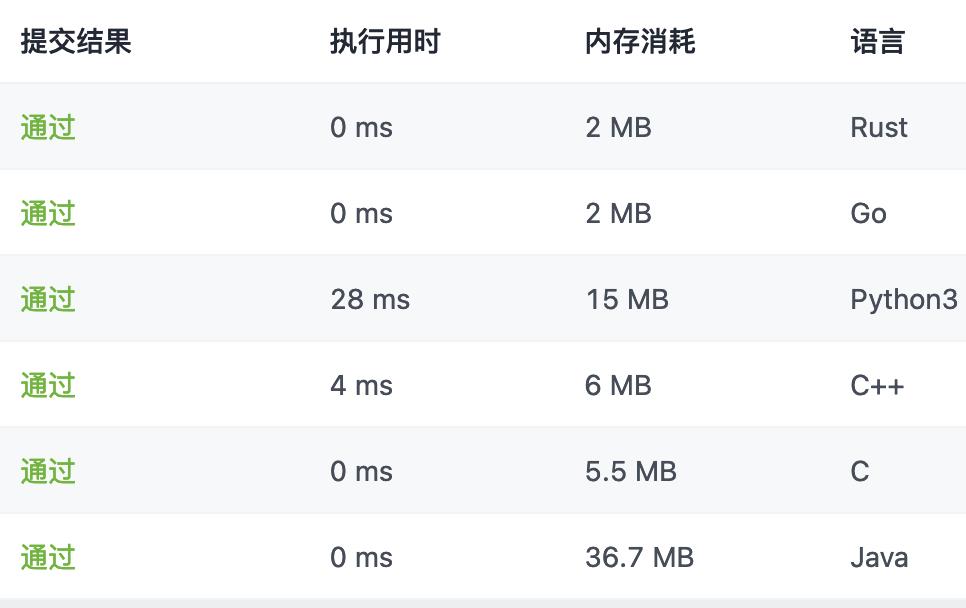算法学习771. 宝石与石头(java / c / c++ / python / go / rust)
Posted 二当家的白帽子
tags:
篇首语:本文由小常识网(cha138.com)小编为大家整理,主要介绍了算法学习771. 宝石与石头(java / c / c++ / python / go / rust)相关的知识,希望对你有一定的参考价值。
非常感谢你阅读本文~
欢迎【👍点赞】【⭐收藏】【📝评论】~
放弃不难,但坚持一定很酷~
希望我们大家都能每天进步一点点~
本文由 二当家的白帽子 https://le-yi.blog.csdn.net/ 博客原创~
文章目录
771. 宝石与石头:
给定字符串J 代表石头中宝石的类型,和字符串 S代表你拥有的石头。 S 中每个字符代表了一种你拥有的石头的类型,你想知道你拥有的石头中有多少是宝石。
J 中的字母不重复,J 和 S中的所有字符都是字母。字母区分大小写,因此"a"和"A"是不同类型的石头。
样例 1
输入:
J = "aA", S = "aAAbbbb"
输出:
3
样例 2
输入:
J = "z", S = "ZZ"
输出:
0
限制
- S 和 J 最多含有50个字母。
- J 中的字符不重复。
分析
- 常规做法直接双循环就可以了,循环次数就是S的长度乘以J的长度。
- 可以先将S放入哈希表,这样在循环J的时候从哈希表查找要比循环S性能更好。
- 由于宝石种类使用字母表示,所以我们预先知道宝石种类上限,这样可以用数组替代哈希表,性能可以更好。
题解
java
class Solution {
public int numJewelsInStones(String jewels, String stones) {
// 创建一个宝石对照表
boolean[] table = new boolean[128];
int jewelsLen = jewels.length();
for (int i = 0; i < jewelsLen; ++i) {
table[jewels.charAt(i)] = true;
}
// 统计宝石数量
int count = 0;
int stonesLen = stones.length();
for (int i = 0; i < stonesLen; ++i) {
if (table[stones.charAt(i)]) {
count++;
}
}
return count;
}
}
c
int numJewelsInStones(char * jewels, char * stones){
// 创建一个宝石对照表
bool table[128];
memset(table, false, 128);
int jewelsLen = strlen(jewels);
for (int i = 0; i < jewelsLen; ++i) {
table[jewels[i]] = true;
}
// 统计宝石数量
int count = 0;
int stonesLen = strlen(stones);
for (int i = 0; i < stonesLen; ++i) {
if (table[stones[i]]) {
count++;
}
}
return count;
}
c++
class Solution {
public:
int numJewelsInStones(string jewels, string stones) {
// 创建一个宝石对照表
bool table[128];
memset(table, false, 128);
for (char c : jewels) {
table[c] = true;
}
// 统计宝石数量
int count = 0;
for (char c : stones) {
if (table[c]) {
count++;
}
}
return count;
}
};
python
class Solution:
def numJewelsInStones(self, jewels: str, stones: str) -> int:
# 创建一个宝石对照表
table = [False] * 128
for c in jewels:
table[ord(c)] = True
# 统计宝石数量
count = 0
for c in stones:
if table[ord(c)]:
count += 1
return count
go
func numJewelsInStones(jewels string, stones string) int {
// 创建一个宝石对照表
table := [128]bool{}
for _, c := range jewels {
table[c] = true
}
// 统计宝石数量
count := 0
for _, c := range stones {
if table[c] {
count++
}
}
return count
}
rust
impl Solution {
pub fn num_jewels_in_stones(jewels: String, stones: String) -> i32 {
// 创建一个宝石对照表
let mut table = vec![false;128];
jewels.bytes().for_each(|c|{
table[c as usize] = true;
});
// 统计宝石数量
stones.bytes().filter(|c|{
table[*c as usize]
}).count() as i32
}
}

原题传送门:https://leetcode-cn.com/problems/jewels-and-stones/
以上是关于算法学习771. 宝石与石头(java / c / c++ / python / go / rust)的主要内容,如果未能解决你的问题,请参考以下文章